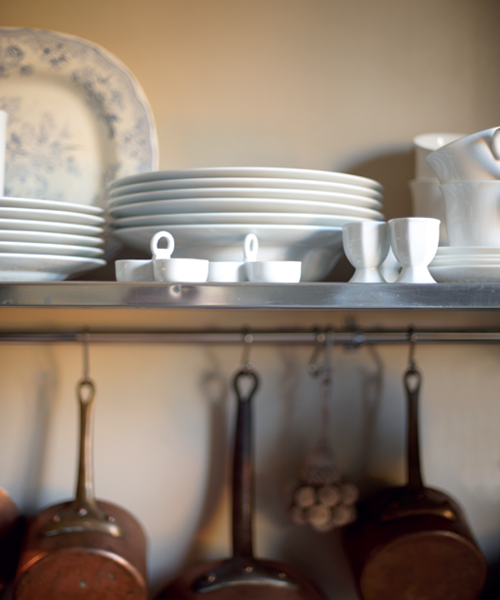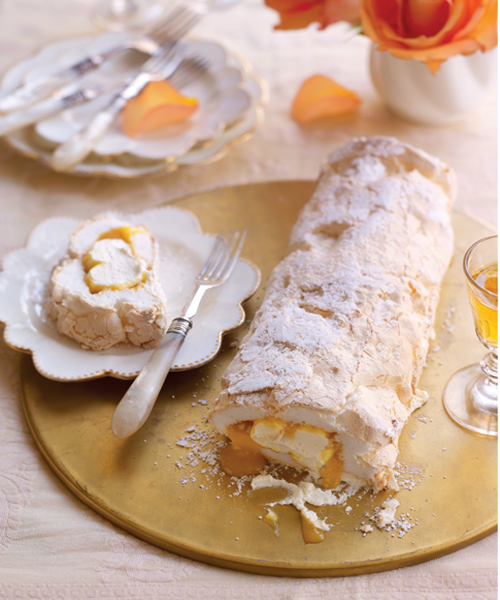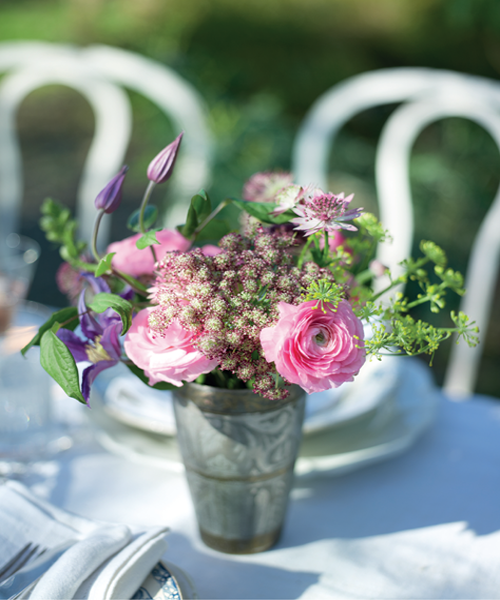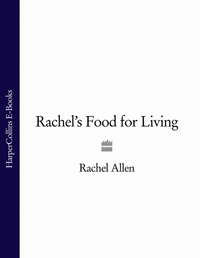
Полная версия
Entertaining at Home
For the celeriac remoulade
½ celeriac
250ml (9fl oz) mayonnaise
Juice of ½ lemon
2 tsp wholegrain or Dijon mustard
13 × 23cm (5 × 9in) loaf tin or casserole dish
1 Melt the butter in a saucepan and add the chopped onion with some salt and pepper, then cover with a lid and cook on a low heat for about 8–10 minutes or until the onion is softened and slightly golden. Set aside to cool.
2 Meanwhile, in a large bowl, mix together the minced meats with the nutmeg, juniper berries and the chopped thyme and season with salt and pepper. Add the cooked onions, then fry a little bit of this mixture in a hot pan and taste for seasoning.
3 Preheat the oven to 180°C (350°F), Gas mark 4, and butter the loaf tin.
4 Place the bacon rashers between two sheets of cling film and roll out with a rolling pin to make the bacon slices thinner and longer. Peel away the cling film from the bacon and line a loaf tin or small casserole by placing the rashers slices side by side along its width, making sure that each piece hangs over each side as it will be folded back over the top of the terrine.
5 Spread one-third of the minced meat mixture over the bacon on the bottom of the tin, then scatter with half the pistachios and arrange half the pieces of game on top to cover the surface. Spread out a second third of the minced meat mixture, followed by another layer of the pistachios and game fillets. Fill with the remaining minced meat mixture, level out with the back of a spoon, then fold the overlapping bacon back over the top to cover.
6 Cover with foil, place in a bain-marie (a roasting tin filled to a depth of a few centimetres with boiling water) and bake in the oven for about 1½ hours or until cooked through or firm to the touch in the centre. (To check that it’s cooked, insert a metal skewer into the centre of the terrine and leave for 10 seconds; the skewer, once removed, will then feel too hot to hold against the inside of your wrist.) Remove the foil after the first 45 minutes.
7 Let the terrine sit in the loaf tin for about 20 minutes before turning out onto a plate and allowing to cool to room temperature. Decorate with some bay leaves and juniper berries.
8 Meanwhile, make the remoulade. Peel and finely slice the celeriac into matchstick-sized pieces or grate using the roughest part of the grater or in a food processor. Then mix with the remaining ingredients in a bowl, seasoning to taste.
9 Cut the terrine into slices and serve with crusty white or sourdough bread and the celeriac remoulade.
RACHEL’S TIP
If you are using your own game meat, use it from the legs, thighs, kidneys, livers and hearts. If you or someone you know has shot a pheasant, pigeon or partridge, you could use up the whole bird in this dish: I tend to use two pheasants or one pheasant and one pigeon, but you could otherwise use a pack of mixed game from the butcher or a supermarket.
Penne with asparagus and Parma ham
Parma ham is one of the world’s great foods, with an incredible complexity to its flavour. This is a simple lunch dish that is all about letting great ingredients speak for themselves.
SERVES 6
600g (1lb 5oz) dried penne
18 asparagus spears
Table salt, sea salt and ground black pepper
25g (1oz) butter
6 tbsp créme fraîche
8 large slices of Parma or Serrano ham, roughly cut into strips
A few shavings of Parmesan cheese per portion (shaved with a peeler)
1 Cook the penne following the instructions on the packet, then drain, reserving a few tablespoons of the cooking liquid, and return to the warm pan (off the heat).
2 While the pasta is cooking, snap off the tough woody part at the bottom of each asparagus spear and discard. Fill a large saucepan to a depth of 4–6cm (1½–2½in) with water, add some table salt and bring to the boil. Tip in the asparagus and cook in the boiling water for 4–8 minutes or until just cooked.
3 Drain the asparagus immediately, then cut each spear at an angle into 3–4 shorter lengths. Place in a bowl, add the butter and season with sea salt and pepper.
4 Add the crème fraîche to the drained pasta in the pan and toss to coat, then tip in the asparagus and Parma ham and season to taste with sea salt and pepper. Serve in warmed bowls with a few shavings of Parmesan on top of each portion.
Venison sausages with celeriac purée
These skinless sausages make a substantial, comforting meal — a great winter lunch. Celeriac is quite an ugly-looking vegetable — those gnarled roots look positively ancient. When peeling it, you’ll find the skin goes quite deep in places. But beneath that knobbly armour is flesh that, when cooked, has a subtle flavour with just a hint of celery.
SERVES 4–6 MAKES 12 SAUSAGES
25g (1oz) butter
1 onion, peeled and diced
300g (11oz) venison, minced or pulsed in a food processor
200g (7oz) minced pork (at least 20% fat)
50g (2oz) fresh white bread crumbs
1 egg, beaten
2 cloves of garlic, peeled and crushed or finely grated
1 tbsp chopped rosemary leaves
1 tbsp wholegrain mustard
Salt and ground black pepper
1–2 tbsp olive oil
For the celeriac purée
1 celeriac, peeled and chopped into 1–2cm (½–¾in) dice
2 floury potatoes, peeled and cut into 1–2cm (½–¾in) dice
400ml (14fl oz) milk
2 tbsp single or regular cream
15g (½oz) butter
1 To make the sausages, melt the butter in a large frying pan on a medium-high heat, then add the onion and fry, stirring occasionally, for 8–10 minutes until slightly golden. Set aside.
2 Meanwhile, mix all the other ingredients except the seasoning and oil in a large bowl. Season with salt and pepper, then add the cooled onions to the mixture. If the mixture is very wet, add a few more breadcrumbs.
3 Preheat the oven to 200°C (400°F), Gas mark 6. Place a little bit of the mixture in the frying pan and cook for 1–2 minutes to check for seasoning. Shape the sausage mixture into about 12 sausages. Pour the olive oil into the frying pan and, on a medium heat, brown the sausages on every side. Then place on a baking tray and bake in the oven for 10 minutes or until cooked through.
4 For the purée, place the celeriac and potatoes in a large saucepan, then pour over the milk to just cover, simmer on a medium-low heat for about 15 minutes, then drain and mash very well. Season with salt and pepper, then add the cream and the butter. Unless serving immediately, place in a covered, ovenproof dish and keep warm in the oven after the heat has been switched off.
5 Serve the sausages with a spoonful of celeriac purée and a drizzle of cranberry sauce (see tip below).
RACHEL’S TIP
To make cranberry sauce, put 150g (5oz) cranberries in a saucepan with 50ml (2fl oz) water. Bring to the boil, then reduce the heat and simmer gently for 6–8 minutes until the cranberries have burst and are softened. Stir in 75g (3oz) caster sugar until dissolved.

Stocks
Many of the recipes in this book require stocks and nothing can compare to a homemade broth of boiled bones, vegetables and herbs. Stocks can be made in advance, stored in small containers and kept in the freezer for handy access. The recipes here are just a guideline but try not to add too much of any one vegetable or the flavour may dominate the stock. Livers are unwelcome as they will make the stock bitter, but necks, hearts and wing tips are perfect. Also avoid starchy vegetables, such as potatoes or parsnips, as they will turn the stock cloudy. Don’t use salt when making a stock as if you eventually reduce it, the salt will remain and the liquid could be too salty. If you wish to concentrate the flavour, place the stock on a high heat and boil, uncovered, to reduce the liquid. To make your own frozen stock cubes, reduce the liquid to about a quarter of its original volume. Allow to cool and then pour into ice cube trays and freeze. Stocks can be refrigerated for three days or frozen for two months.
Vegetable stock
MAKES ABOUT 2 LITRES (3½ PINTS)
2 onions, peeled and roughly chopped
2 leeks, trimmed and roughly chopped
3 sticks of celery, trimmed and roughly chopped
3 carrots, peeled and roughly chopped
½ fennel bulb, roughly chopped
Bunch of parsley stalks
1 small sprig of rosemary
1 sprig of thyme
1 Place all the ingredients into a large saucepan or casserole dish. Add enough cold water to cover the ingredients by about 10cm (4in) and bring to a simmer.
2 Let the stock continue to simmer for an hour, then strain the liquid and discard the vegetables.
Beef stock
MAKES 3–4 LITRES (5–6¾ PINTS)
2kg (4lb 4oz) beef bones, preferably with a little meat still on
2 onions, peeled and cut in half
2 carrots, peeled and cut in half
2 sticks of celery, trimmed and roughly chopped
Bunch of parsley stalks
1 tbsp tomato paste
1 sprig of thyme
1 bay leaf
1 Preheat the oven to 230°C (450°F), Gas mark 8. Place the bones on a roasting tray and roast in the oven for about 30 minutes until browned.
2 Transfer them to a large saucepan and deglaze the roasting tray by placing it on a medium heat on the hob. Pour a little cold water into the tray (enough to cover the bottom) and bring to the boil, scraping the bottom with a whisk to dissolve the caramelised juices that are stuck to the tray. Then pour on top of the bones in the saucepan with the rest of the ingredients. Top up with enough cold water to cover everything by a good 10cm (4in) and bring to the boil. Reduce the heat and bring the stock to a simmer.
3 Leave the saucepan to simmer gently for 5–6 hours, skimming the foam off the top from time to time.
4 Strain the stock, discarding the bones and vegetables. Allow to cool so the fat will rise to the top where it is easy to skim off.
Chicken stock
MAKES 1–2 LITRES (1¾–3½ PINTS)
1 chicken carcass, cooked or raw
1–2 carrots, peeled and roughly chopped
1 onion or 4 spring onions, peeled and cut in half
1 leek or even just the green part, trimmed and roughly chopped
1 sticks of celery, trimmed and roughly chopped
Bunch of parsley stalks
1 sprig of thyme
1 small bay leaf
1 Place all the ingredients in a large saucepan or casserole dish. Add enough cold water to cover everything by about 8cm (3in) and bring to the boil. Reduce the heat and bring the stock to a gentle simmer and then leave for about 2 hours. For the best flavour, skim the foam off the surface from time to time, though it’s not completely necessary.
2 Strain the stock so you are left with just liquid and discard the vegetables and carcasses. Chill, then lift the fat off the top and discard.
Polenta, orange and almond cake
This flourless cake is made with a mixture of ground almonds and polenta, which gives a texture that is dense yet soft. The hot syrup poured over at the end makes it incredibly moist.
SERVES 6–8 VEGETARIAN
375g (13oz) butter, softened, plus extra for greasing
200g (7oz) medium or coarse polenta, plus 1 tbsp extra for dusting
375g (13oz) caster sugar
5 eggs
Finely grated zest of 2 oranges
Juice of 1 orange
300g (11oz) ground almonds
1 tsp baking powder
4 tbsp chopped pistachio nuts, to serve
For the syrup
Juice and finely grated zest of 1 orange
50g (2oz) caster sugar
23cm (9in) diameter spring-form/loose-bottomed tin with 5cm (2in) sides
1 Preheat the oven to 170°C (325°F), Gas mark 3. Butter the cake tin, place a disc of greaseproof paper in the bottom and dust the tin with 1 tablespoon of polenta.
2 Cream the butter in a large bowl or in an electric food mixer until soft. Add the sugar and beat until the mixture is light and fluffy. Beat in the eggs, one at a time, then add the orange zest and juice. Fold in the remaining ingredients and spoon the mixture into the prepared tin. Place in the oven and cook for 80–90 minutes or until a skewer inserted into the centre of the cake comes out clean.
3 Remove the cake from the oven and allow it to cool in the tin for about 20 minutes before transferring to a serving plate. Using a skewer, make about eight holes, each around 2.5cm (1in) deep, across the surface of the cake.
4 To make the syrup, mix together the orange zest and juice with the caster sugar in a small saucepan. Bring to the boil and keep boiling for 2 minutes, then remove from the heat and immediately drizzle all over the polenta cake. Serve warm or at room temperature with a scattering of pistachio nuts and a dollop of crème fraîche.
RACHEL’S TIP
Depending on the oven, I sometimes quickly open it to place a piece of foil on top of the cake after 45 minutes, to prevent it from getting too brown.
Almond meringue with apricot purée
The apricot purée is also divine served with natural yoghurt as a quick snack or for breakfast. It can be stored in the fridge in an airtight container and will keep for up to a week.
SERVES 6–8 VEGETARIAN
3 egg whites
175g (6oz) caster sugar
100g (3½oz) nibbed or chopped almonds
200ml (7fl oz) double or regular cream
Icing sugar, for dusting
For the purée
2 tbsp lemon juice
100g (3½oz) caster sugar
225g (8oz) ready-to-eat dried apricots
1 Preheat the oven to 150°C (300°F), Gas mark 2. Line two baking sheets with baking parchment.
2 Place the egg whites in a spotlessly clean dry bowl and whisk until the mixture is fairly stiff. Add a quarter of the sugar and continue to whisk until the mixture holds its shape. Gently fold in the remainder of the sugar, followed by the nibbed almonds.
3 Spoon half the meringue mixture onto each of the lined baking sheets and gently spread the meringue on each sheet to form a round 20–22cm (8–9in) in diameter. If you can fit both meringues on one tray, it’s easier if you’re not cooking in a fan oven.
4 Bake in the oven together for 25–30 minutes or until crisp on the outside and cream coloured. (If cooked, the meringue will lift easily off the paper.) Once the meringue is cooked, if possible leave it inside the oven for 1 hour to allow it to cool down slowly and lessen the risk of it cracking. Alternatively, remove it from the oven but don’t put it anywhere too cold as soon as you take it out.
5 To make the purée, fill a large saucepan with 850ml (1½ pints) of water, add the lemon juice and sugar and bring to the boil. Add the apricots, return to the boil then reduce the heat and simmer, uncovered, for about 20 minutes or until the apricots are softened. Remove from the heat and allow to cool, then place in a blender or food processor and whiz to form a purée.
6 Place a meringue round onto a serving plate or cake stand. Whip the cream and spread onto the meringue round, pour over some apricot purée, then gently place the other round on top, saving the best-looking one for this. Dust with icing sugar and cut into slices to serve, with the remaining purée on the side.

Orange meringue roulade
Here is a light dessert with a lovely citrus zing. The orange curd is delicious and the quantity given here makes twice the amount you will need for the roulade filling. Either just make half the quantity given (using 1 whole egg and 1 yolk) or make the full amount and try it served on pancakes, toast or even ice cream. The curd can be stored in an airtight plastic container in the fridge for up to a week or in a sealed jam jar for two weeks.
SERVES 8–10 VEGETARIAN
Vegetable or sunflower oil, for oiling
4 egg whites
225g (8oz) caster sugar
Icing sugar, for dusting
200ml (7fl oz) orange curd
500ml (18fl oz) whipped cream
For the orange curd
2 eggs
1 egg yolk
100g (3½oz) butter
175g (6oz) caster sugar
Juice and finely grated zest of 3 oranges
20 × 30cm (8 × 12in) Swiss roll tin
1 First make the orange curd. Whisk together the egg and egg yolk. Then melt the butter in a saucepan on a low–medium heat. Add the sugar and orange juice and zest, and pour in the eggs.
2 Stir constantly with a wooden spoon, still over a low heat (if it is too high, the egg will scramble), for 10–15 minutes or until the mixture is fairly thick. If you find the egg does start to scramble, dip the bottom of the pan in very cold water and then sieve the mixture. The curd is ready when the mixture is thick enough to coat the back of the wooden spoon and leave a definite mark when you draw a line in it with your finger. It will thicken further once cool.
3 Remove the curd from the heat, pour into a bowl and allow to cool. If you wish to keep this for two weeks, store the orange curd in sterilised jars.
4 To make the roulade, reheat the oven to 180°C (350°F), Gas mark 4. Line the Swiss roll tin with foil, then brush with a little vegetable or sunflower oil.
5 Place the egg whites and sugar in the bowl of an electric mixer and whisk for about 10 minutes until the mixture forms stiff peaks.
6 Spoon the mixture into the tin and spread it out evenly. Place in the oven and cook for 15–20 minutes or until it looks marshmallowy and lightly springy to the touch in the centre.
7 Remove from the oven and turn the meringue out onto a sheet of baking parchment or foil that has been liberally dusted with icing sugar. Peel off the foil from the base and allow to cool.
8 To assemble the roulade, first spread the orange curd evenly to cover the meringue, then spread the whipped cream over the orange curd. Gently roll up the roulade starting at one of the long edges and rolling away from you, to form a log shape. Transfer to a long serving plate, making sure the ‘join’ is facing down, and dust with icing sugar. Cut into slices to serve.

Apple snow with shortbread biscuits
This fantastically light meringue dessert is very quick to prepare, especially if you make the purée in advance and then just fold it into the whisked egg whites at the last minute. Eat on its own or with the shortbread biscuits. Once made, you can store these in a tin-if there are any left over! This recipe contains raw eggs, which should be avoided by pregnant women, the very young and the very old.
SERVES 6 VEGETARIAN
450g (1lb) cooking apples, such as Bramley, peeled, cored and cut into chunks
175g (6oz) caster sugar
2 egg whites
Shortbread biscuits (see below), to serve
1 Place the apple chunks and sugar in a large saucepan with 100ml (3½fl oz) water, cover with a lid and simmer on a low heat for 10 minutes or until the apples are quite soft. Remove the lid and continue to simmer for another 3–4 minutes or until the apples are quite mushy and all the liquid has evaporated.
2 Remove from the heat, allow to cool a little, then whiz in a blender or food processor for a few minutes to make into a purée. Taste the purée to make sure it is sweet enough, adding a little more sugar if needed. It should be slightly sweeter than you want it to be eventually as its flavour will be diluted by the egg whites. Transfer to a large bowl and allow to cool.
3 When you are ready to serve, whisk the egg whites in a spotlessly clean bowl until they form stiff peaks. Gently fold the egg whites into the apple purée. Serve in glass bowls or glasses with the shortbread biscuits on the side.
Shortbread biscuits
MAKES ABOUT 25 BISCUITS VEGETARIAN
150g (5oz) plain flour, plus extra for dusting
50g (2oz) caster sugar
100g (3½oz) butter, softened
Icing sugar, for dusting (optional)
1 Preheat the oven to 180°C (350°F), Gas mark 4.
2 Place the flour and sugar in a large bowl, rub in the butter then bring the mixture together to form a stiff dough, or just whiz all the ingredients together briefly in a food processor until almost combined.
3 Pat out the dough into a round about 2cm (¾in) thick, then cover with greaseproof paper or cling film and chill in the fridge for about 20 minutes. On a work surface lightly dusted with flour, roll out the dough to about 5mm (¼in) thick and cut into shapes — round, square, rectangular, heart-shaped, whatever takes your fancy. Place carefully on 2 baking sheets (no need to grease or line) and cook in the oven for 6–10 minutes or until pale golden.
4 Take out of the oven and allow to sit on the baking sheets for a few seconds to firm up slightly (don’t leave them any longer or they will stick). Transfer to a wire rack to cool, then dust with icing sugar if eating with the Apple Snow.
Mango and raspberry Bellinis
The classic Bellini cocktail — a divine combination of sparkling wine (normally Prosecco) and fresh peach juice — was invented in the 1940s by Giuseppe Cipriani, founder of the celebrated Harry’s Bar in Venice. The cocktail’s particular shade of pink supposedly reminded Cipriani of the colour of the toga worn by a saint in a painting by Renaissance artist Giovanni Bellini-hence the name.
SERVES 6 VEGETARIAN
1 × 750ml bottle of sparkling wine, such as Prosecco or Cava
For the fruit purée
1 mango, peeled, stone removed and flesh chopped
100g (3½0z) fresh or frozen and defrosted raspberries
3 tbsp lemon juice
4 tbsp caster sugar
6 champagne flutes
1 Place all the ingredients for the fruit purée in a food processor and whiz for 1–2 minutes, then push through a sieve.
2 Mix in a jug or fill glasses with one-third purée and two-thirds sparkling wine, stirring gently to combine. Serve chilled.
VARIATIONS
Mango Bellinis: Purée the flesh of 1 large mango with 3 tablespoons of lime juice and 3 tablespoons of caster sugar, then mix with the sparkling wine, as above.









